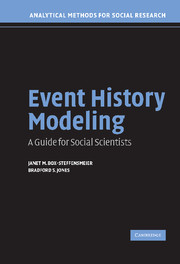Book contents
- Frontmatter
- Contents
- List of Figures
- List of Tables
- Preface
- 1 Event History and Social Science
- 2 The Logic of Event History Analysis
- 3 Parametric Models for Single-Spell Duration Data
- 4 The Cox Proportional Hazards Model
- 5 Models for Discrete Data
- 6 Issues in Model Selection
- 7 Inclusion of Time-Varying Covariates
- 8 Diagnostic Methods for the Event History Model
- 9 Some Modeling Strategies for Unobserved Heterogeneity
- 10 Models for Multiple Events
- 11 The Social Sciences and Event History
- Appendix: Software for Event History Analysis
- References
- Index
10 - Models for Multiple Events
Published online by Cambridge University Press: 05 September 2012
- Frontmatter
- Contents
- List of Figures
- List of Tables
- Preface
- 1 Event History and Social Science
- 2 The Logic of Event History Analysis
- 3 Parametric Models for Single-Spell Duration Data
- 4 The Cox Proportional Hazards Model
- 5 Models for Discrete Data
- 6 Issues in Model Selection
- 7 Inclusion of Time-Varying Covariates
- 8 Diagnostic Methods for the Event History Model
- 9 Some Modeling Strategies for Unobserved Heterogeneity
- 10 Models for Multiple Events
- 11 The Social Sciences and Event History
- Appendix: Software for Event History Analysis
- References
- Index
Summary
The models discussed to this point have all involved so-called “single-state” processes, or equivalently, one-way transition models. In such models, there is a singular event of interest and once the event is experienced—or once an observation fails—the observation leaves the risk set and is assumed to be no longer at risk of returning to the previously occupied state. Concomitantly, in a single-state process, we assume that an observation is only at risk of experiencing a single event; that is, the observation is not at risk of making a transition to another state. Is this a reasonable assumption? Often it is not, and, at a minimum, it is an assumption that should be tested. In this chapter, we consider some models that account for repeatable events.
Additionally, in previous applications, we did not attempt to account for the different kinds of events that could occur. Some research problems, however, may lead one to consider how observations are at risk of experiencing one of several kinds of events. Problems of this kind are sometimes referred to as multi-state processes or competing risks processes because survival times may terminate in a variety of substantively interesting ways. In this chapter, we consider event history approaches to deal with the issue of competing risks.
The issues of repeatable events and competing risks serve to highlight the greater concern of this chapter: how does one employ event history models in the face of complicated social processes?
- Type
- Chapter
- Information
- Event History ModelingA Guide for Social Scientists, pp. 155 - 182Publisher: Cambridge University PressPrint publication year: 2004
- 1
- Cited by

